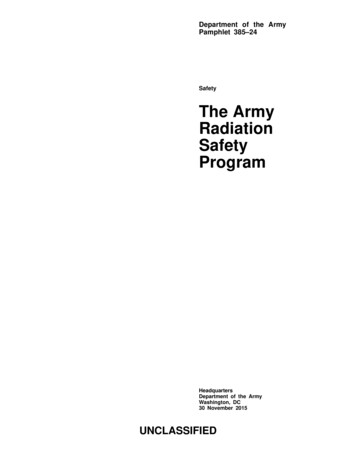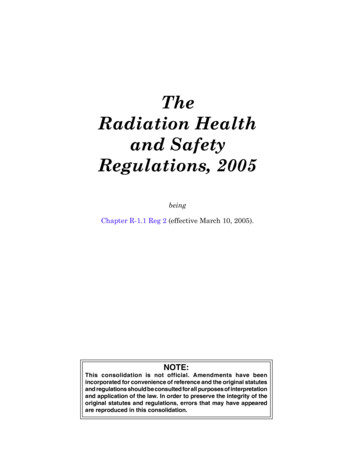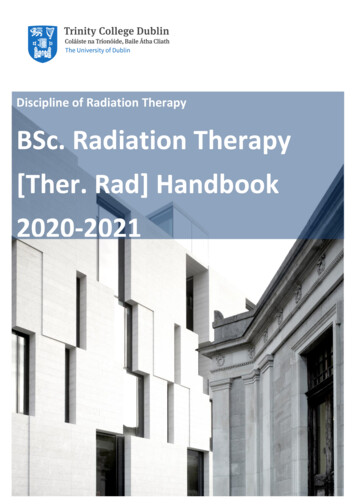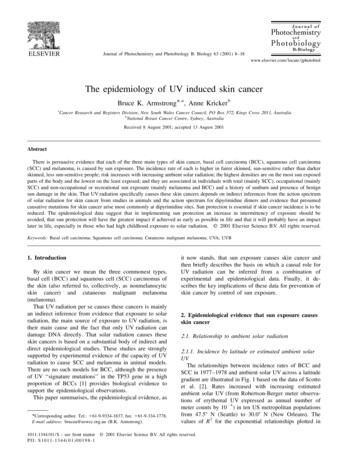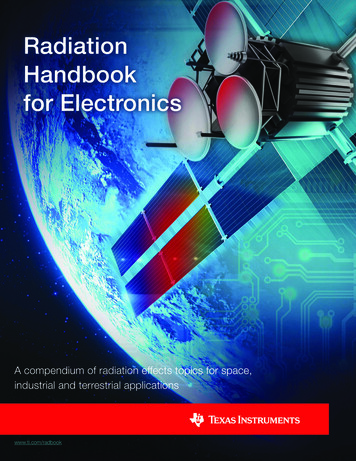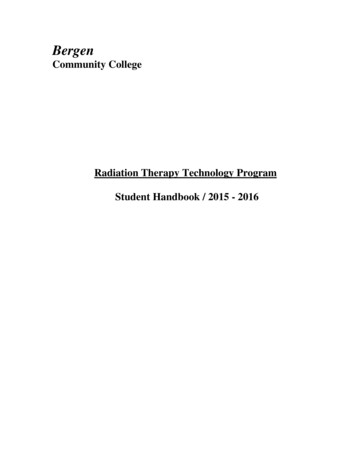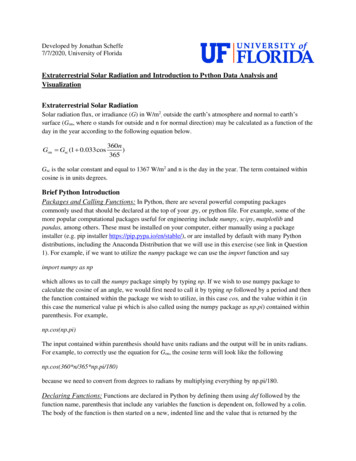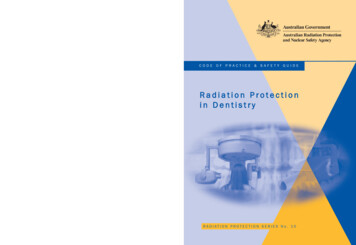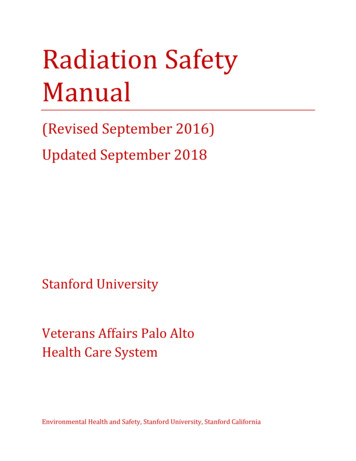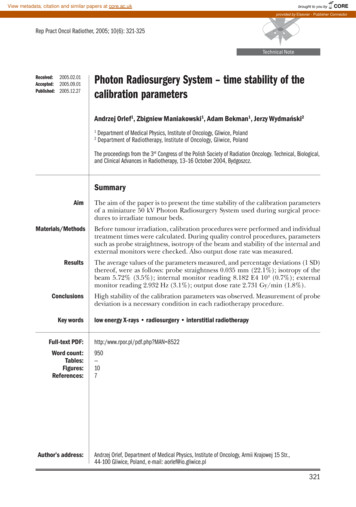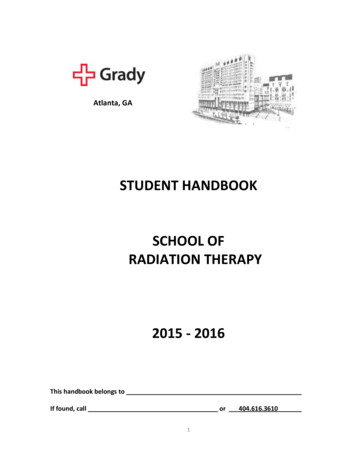
Transcription
Atlanta, GASTUDENT HANDBOOKSCHOOL OFRADIATION THERAPY2015 - 2016This handbook belongs toIf found, callor1404.616.3610
2
TABLE OF CONTENTSIntroduction and Institutional PoliciesDepartmental StaffHospital Vision/Mission/Core ValuesImaging Services Vision and MissionProgram Mission, Goals, and Learning OutcomesAccreditationEqual Opportunity PolicyGeneral PolicyTime of AdmissionHealth RequirementCommunicable Disease PolicyStandard PrecautionsTechnical Standards and Americans with Disabilities PolicyDrug/Alcohol PolicyRadiation Safety PolicyRadiation Safety Pregnancy Policy for Declared Pregnant WorkersPregnancy 5-161616-17General Information and Student ServicesParking FacilitiesPublic TransportationWellness CenterHealth CareTB ControlInfluenza Vaccination RequirementAccident/Incident ReportEmployee Assistance ProgramIdentification BadgesComputers and TutorialsLibrariesPhotocopies and FacsimilesCafeteria, Chick-fil-ASnack Machines, Henry’s, , Grab-n-GoSmokingDiscounts on Entertainment EventsGift ShopsPublic Safety DepartmentPublic Safety Escort ServiceLost and FoundLockersNotary PublicTelephone InstructionsFrequently Called NumbersTelephones, Cell Phones, Pagers, and Electronic DevicesBulletin Boards -2222222222222222-2323-2424253
Mail for StudentsClassroom FacilitiesInstructors OfficesVisitors on CampusStudent GovernmentProfessional Organizations and Student ActivitiesSchool ActivitiesGeneral Clearance ProcedureGraduation RequirementsGraduation Clearance ProcedureGraduation and Technology FeesGraduation CeremonyGraduation AwardsCertification by the American RegistriesPlacement Following GraduationStudent 28Organizational ProceduresFinancial AidSatisfactory ProgressFinancial Aid ProgramsWorkforce in Action (WIA) ProgramsStudent Responsibilities Regarding Financial AidCourse RegistrationWithdrawal PolicyTuition Refund PolicyInstitutional Pro Rata Refund PolicyReturn Policy for Title IV Grant and Loan ProgramsVeterans Refund PolicyStudent ScholarshipsStudent RecordsStudent EvaluationsAccess to Students Personal RecordsOfficial TranscriptsChange in StatusReference/Release of InformationReadmission to the ProgramTransfers and Credit for Previous Education and 32-3333333333Customer Service PoliciesStudent PoliciesDepartmental RelationshipsConfidential InformationHealthcare for Prison InmatesHouse Rules for Imaging ServicesPatient RightsNational Patient Safety Goals (2015)Patient Records3333-34343434-3535-3636-37374
Anti-Harassment PolicySolicitation/Distribution PolicyEthics PolicySocial Media PolicyPatient/Visitor Relations37Page37-383838-3939Safety PoliciesRadiology Safety PolicyFire PlanDisaster PlanTornado PlanEmergency Codes39-4444-4949-505050-51Disciplinary PoliciesThree-Month Probationary PeriodProbationAttitudinal/Disciplinary ProbationClinical ProbationAcademic ProbationTerminationStudent CounselingProblems and ComplaintsDue Process and Appeal MechanismStandards of Behavior and c EducationClass ResponsibilityAbsence from ExaminationGuest SpeakersGrading SystemAcademic IntegritySchool Assignments and Course RegistrationCourse DescriptionsAcademic Calendar, Class Schedule and Credit HoursJRCERT StandardsSection II59595959606060-6464-6768-77Clinical EducationSection III with separate table ofcontentsStudent Handbook Agreement5
6
INTRODUCTION AND INSTITUTIONAL POLICIESDEPARTMENTAL STAFFSCHOOLS OF RADIATION AND IMAGING TECHNOLOGIESKevin Kindle, MBA, RT(T)Jessie McFrySabrina TwolionsEducation Manager/Dean of StudentsStudent Admissions CoordinatorFinancial Aid Officer/RegistrarSCHOOL OF RADIOLOGIC TECHNOLOGYBetsy Kerr, BMSc, RT(R)Sylvia Brooks-Dowl, BMSc, RT(R)Troy Maxwell, RT(R)Terrie Montgomery, BS, RT(R)Willie Hall, RT(R)Clifton Davis, RT(R)Lakeshia Lloyd Wilson, RT(R)Nartoshia Wilson, RT(R)Sommre Robinson, RT(R)Antoine Richards, BS, RT(R)David East, RT(R)Johnette Tucker, BSRS, RT(R)Jeannette Malko, BA, RT(R)Karen Moore, RT(R)Starla Jones, RT(R)Suzanne Butler, RT(R)Jordan-Lee Sowell, RT(R)Shareka Flennory, RT(R)Diane Manning, AS, RT(R)Martha Elizabeth Ledford, RT(R)Rochelle Owen, AAS, RT(R)Shauna Cantrell, RT(R)Falon Perry, RT(R)Angela Scott, BS, RT(R)Evelyn Smith, BA, RT(R)Michael Daise, RT(R)Portia Dennis, RT(R)Harry Prevatt, RT(R)Michael Demps, RT(R)April Gilreath, RT(R)Kimmeone Morgan, AAS, RT(R)Rebecca Craig, RT(R)Karissa Merrifield, AAS, RT(R)Kimberly Dean, AS, RT(R)Stephanie Harper, RT(R)Program Director/ManagerRadiography Training CoordinatorClinical Instructor/GradyClinical Instructor/GradyDesignated Clinical Instructor/Grady ERDesignated Clinical Instructor/Grady ERDesignated Clinical Instructor/Grady ERDesignated Clinical Instructor/GradyDesignated Clinical Instructor/GradyDesignated Clinical Instructor/GradyDesignated Clinical Instructor/GradyDesignated Clinical Instructor/GradyDesignated Clinical Instructor/GradyDesignated Clinical Instructor/GradyDesignated Clinical Instructor/GradyDesignated Clinical Instructor/CHOA at Hughes SpaldingDesignated Clinical Instructor/CHOA at Hughes SpaldingDesignated Clinical Instructor/CHOA at Hughes SpaldingDesignated Clinical Instructor/CHOA at Hughes SpaldingDesignated Clinical Instructor/CHOA at Mt. ZionDesignated Clinical Instructor/CHOA at Mt. ZionDesignated Clinical Instructor/CHOA at Satellite BlvdDesignated Clinical Instructor/CHOA at Town CenterDesignated Clinical Instructor/CHOA at Town CenterDesignated Clinical Instructor/Asa YanceyDesignated Clinical Instructor/Ponce de LeonDesignated Clinical Instructor/EUHMDesignated Clinical Instructor/PiedmontDesignated Clinical Instructor/Piedmont WestDesignated Clinical Instructor/Piedmont WestDesignated Clinical Instructor/AMCDesignated Clinical Instructor/AMCDesignated Clinical Instructor/FC Dept of H & WDesignated Clinical Instructor/Resurgens AustellDesignated Clinical Instructor/Resurgens AustellDesignated Clinical Instructor/Resurgens CummingDesignated Clinical Instructor/Resurgens Douglasville7
Anjali Bagade, RT(R)Erin Hill, AS, RT(R)Berline Polycart, AAS, RT(R)Bilal Lowndes, RT(R)Stacy Rivardo, BMSc, RT(R)Brandon Smith, RT(R)Trelicia Cox, AS, RT(R)Judy Huggins, AS, RT(R)Allison Warner, BS, RT(R)Lisa Vaccaro, RT(R)Felicia Hicks, RT(R)John Malko, PhDJack Fountain, MDDesignated Clinical Instructor/Resurgens Johns CreekDesignated Clinical Instructor/Resurgens KennesawDesignated Clinical Instructor/Resurgens MariettaDesignated Clinical Instructor/Resurgens MidtownDesignated Clinical Instructor/Resurgens St. Joseph’sDesignated Clinical Instructor/Resurgens St. Joseph’sDesignated Clinical Instructor/POC MainDesignated Clinical Instructor/POC Sports MedDesignated Clinical Instructor/POC College ParkDesignated Clinical Instructor/POC NorthsideDesignated Clinical Instructor/POC NorthsideAssistant Professor/Emory UniversityMedical AdvisorSCHOOL OF RADIATION THERAPYKevin Kindle, MBA, RT(T)Sharam Ghavidel, MSHPChristie Jarrio, MS DABRSara Tolley, RT(R)(T)Mary Monteith, BS, RT(R)(T)Michael Bowe, RT(R)(T)Tim Crenshaw, RT(R)(T)Britni Thomas, BS, RT(T)Kenny Tyus, RT(R)(T)Stephen Lee, RT(T)Karen Godette, MDProgram Director/ManagerMedical Physicist/Didactic InstructorMedical Physicist/Didactic InstructorDidactic InstructorClinical Supervisor/GradyClinical Supervisor/TECMClinical Supervisor/TECClinical Supervisor/WellStar KennestoneClinical Supervisor/PiedmontClinical Supervisor/NorthsideMedical AdvisorSCHOOL OF DIAGNOSTIC MEDICAL SONOGRAPHYJudy Billings, BSRT, RT(R), RDMSJessi Clark, BS, RT(R), RDMSProgram Director/ManagerSonography Training CoordinatorHOSPITAL ADMINISTRATIONJohn M. HaupertChristopher R. MosleyDr. Kelvin HollowayJoseph PriceDr. Jackie ReasorPresident/Chief Executive OfficerExecutive Vice President/Chief Operating OfficerInterim Chief Medical Officer/Chief of StaffAdministrative Director/Imaging ServicesInterim Cancer Center Executive DirectorRADIOLOGY AND ONCOLOGY MEDICAL DIRECTORSCarolyn Meltzer, MDWalter Curran, MDKaren Godette, MDJack Fountain, MDJerome Landry, MDMark McLaughin, MDRaghuveer Halkar, MDChairman, RadiologyChairman, Radiation Oncology, TECChairman, Radiation Oncology, TECMChief of Service, Radiology/Director, Neuroradiology (Grady)Chief of Service, Radiation Oncology, GHSChief of Service, WellStar KennestoneChief of Service, Clinical Nuclear Medicine8
Roger Williams, MDMichael Terk, MDAmit Saindane, MDOmari Johnson, MDGail Peters, MDFred Murphy, MDStephen Simoneaux, MDArthur Stillman, MDKatherine Gundry, MDDirector, Vascular/Interventional Radiology (Emory)/Interim Director, Abdominal ImagingDirector, Musculoskeletal ImagingDirector, Neuroradiology (Emory)Director, Emergency RadiologyDirector, Vascular/Interventional Radiology (Grady)Director, Abdominal ImagingDirector, Pediatric RadiologyDirector, Thoracic Radiology (Emory)Director, Breast ImagingGRADY HEALTH SYSTEMVISIONGrady Health System will become the leading public academic healthcare system in theUnited States.MISSIONGrady Health System improves the health of the community by providing quality,comprehensive healthcare in a compassionate, culturally competent, ethical and fiscallyresponsible manner. Grady maintains its commitment to the underserved of Fulton andDeKalb counties, while also providing care for residents of metro Atlanta and Georgia.Grady leads through its clinical excellence, innovative research and progressive medicaleducation and training.COREVALUESExcellence: Grady Health System strives for the highest quality in all that we do. The artand science of healing require a commitment to lifelong learning and professionalism.Customer Service: Grady Health System is motivated by a sincere concern forthe well-being of all people, and we will strive to serve everyone with dignity, respect andcompassion.Ethics: Grady Health System will maintain the highest ethical standards throughits actions and decisions.Teamwork: Grady Health System cultivates an environment of communication,respect, trust and collaboration.Commitment: Grady Health System is motivated by pride and dedication, determined toachieve the goals of the organization and willing to give our best efforts at all times.IMAGING SERVICESVISIONGrady Health System Department of Imaging Services vision is to be the regional leaderregional leader in public academic imaging healthcare. We will advance thequality of our standard of care through technological advancement, comprehensivetraining, and the expansion of our professional expertise. All areas of Medical Imaging willprovide the highest level of expert care from Diagnostic radiology to advanced innovativespecialty procedures. Grady’s Medical imaging commitment remains thesame comprehensive quality, expert delivery and compassionate care in every image.MISSIONGrady Health System’s Imaging Services mission is to provide comprehensive quality9
to all the communities we serve. We will provide our expert care with the mostinnovative and advanced techniques, be good stewards of our finances while maintaining thehighest level of compassion and respect for the communities we serve.MISSION, GOALS and LEARNING OUTCOMESSCHOOL OF RADIOLOGIC TECHNOLOGYMissionIt is the mission of the School of Radiologic Technology to provide a quality education that activelyengages the student in the classroom, laboratory, and clinical experiences that will produce an entrylevel radiographer and prepare the student to challenge the national certification examination.Goal 1:Students will be clinically competent.Learning Outcomes1.1Students will practice radiation protection.1.2Students will apply knowledge of radiographic procedures.1.3Students will evaluate images.1.4Students will apply provide appropriate patient care.1.5Students will select appropriate exposure factors.Goal 2: Students will communicate effectively.Learning Outcomes2.1Students will demonstrate knowledge of patient communication skills.2.2Students will demonstrate effective oral communication.2.3Students will demonstrate effective written communication skills.Goal 3: Students will use critical thinking and problem-solving skills.Learning Outcomes3.1Students will identify ethical dilemmas.3.2Students will demonstrate critical thinking and decision-making skills.3.3Students will adapt procedures for trauma, non-routine, and age-specific patients.3.4Students will recognize emergency patient conditions.Goal 4: Students will demonstrate professional development and growth consistent with programmission and expected outcomes.Learning Outcomes4.1Students will demonstrate a professional work ethic in the clinical arena.4.2Students will demonstrate dependability in the clinical arena.4.3Students will demonstrate confidence in the clinical arena.4.4Students will demonstrate the ability to function as team players in the clinicalarena.Goal 5: The program will measure ongoing effectiveness.Learning Outcomes5.1Graduates will pass the ARRT certification exam on the first attempt.5.2Graduates will complete the program within 24 months.5.3Of those pursuing employment, graduates will be employed within 12 months10
5.45.5post-graduation.Graduates will be satisfied with their education.Employers will be satisfied with the graduate’s education.SCHOOL OF RADIATION THERAPYMissionIt is the mission of the School of Radiation Therapy to provide a quality education that actively engagesthe student in the classroom, laboratory, and clinical experiences that will produce an entry leveltherapist and prepare the student to challenge the national certification examination.Goal 1:Students will be clinically competent.Learning Outcomes:1.1Students will accurately position patients.1.2Students will evaluate radiation therapy treatment prescriptions, images andtreatment records.1.3Students will provide appropriate patient care.Goal 2:Students will communicate effectively.Learning Outcomes:2.1Students will demonstrate effective oral communication skills.2.2Students will demonstrate effective written communication.Goal 3:Students will use critical thinking and problem-solving skills.Learning Outcomes:3.1Students will evaluate clinical situations using critical thinking and problem solvingskills.3.2Students will recognize setup discrepancies.Goal 4:Students will demonstrate professional development and growth consistent withprogram mission and expected outcomes.Learning Outcomes:4.1Students will discuss the importance of continued professional development.4.2Students will maintain a professional network.Goal 5:The program will measure ongoing effectiveness.Learning Outcomes:5.1Graduates will pass the ARRT certification exam on the first attempt.5.2Graduates will complete the program within 12 months.5.3Of those pursuing employment, graduates will be employed within 12 monthspost-graduation.5.4Graduates will be satisfied with their education.5.5Employers will be satisfied with the graduate’s education.11
ACCREDITATIONThe School of Radiologic Technology is an accredited program approved by the Joint Review Committeeon Education in Radiologic Technology, 20 North Wacker Drive, Suite 2850, Chicago, IL 60606, (312) 7045300, mail@jrcert.org, www.jrcert.org .The School of Radiation Therapy is an accredited program approved by the Joint Review Committee onEducation in Radiologic Technology, 20 North Wacker Drive, Suite 2850, Chicago, IL 60606, (312) 7045300, mail@jrcert.org, www.jrcert.org .The School of Radiologic Technology offers a 24-month course of study in diagnostic radiologictechnology. Students satisfactorily completing the program fulfill requirements to write the AmericanRegistry of Radiologic Technologists.The School of Radiation Therapy offers a 12-month course of study in radiation therapy. Studentssatisfactorily completing the program fulfill requirements to write the American Registry of RadiologicTechnologists.EQUAL OPPORTUNITY POLICYGrady Health System offers equal education opportunities to students regardless of race, creed,socioeconomic status, sex, age, handicap, religion, or national origin.GENERAL POLICYThe Administration and/or Faculty reserve the right to make any changes in any administrative,educational, or financial policy which would contribute to the progress of the program. All policiescontained in this handbook apply to students while on site at Grady Health System and when off campuson rotations at clinical affiliates.TIME OF ADMISSIONRadiography and Radiation Therapy classes begin Fall Semester of each year.HEALTH REQUIREMENTStudents must be able to meet the physical and technical requirements necessary for the course of studyin each program.COMMUNICABLE DISEASE POLICYGrady Health System values the role that healthcare workers play in keeping the workplace and patientcare environment safe for everyone. To achieve the highest level of safety, Employee Health Services(EHS) and Infection Control teams work together with hospital leaders, providers, and employees toreduce health risks and to educate through routine and on-going communications regarding issues thatarise as healthcare workers present to EHS and/or result from workplace incidents.Healthcare workers who develop signs and symptoms of possible communicable diseases may seek care12
or be referred to EHS for medical evaluation, treatment, work status determination and/or initiatespecialty referral. Although not an exhaustive list, such communicable diseasesinclude the following: chicken pox/shingleshepatitisdiarrheal illnessesherpetic lesions (uncovered) involving head and neck area of direct patient care giversand food service workersherpetic whitlow (herpes simplex infection of fingers/hands)rubella (German/3-day measles)rubeola (red/hard measles)tuberculosisviral conjunctivitis (pink eye)scabies and pediculosisopen draining lesionsinfluenzafebrile associated illness with temperature 100 degrees F (37.8 degrees C)Healthcare workers may be excluded from duty by EHS, or Emergency Department (ED), if the attendingphysician has been in consultation with the EHS Medical Director, or the Hospital Epidemiologist.Healthcare workers who have been placed off duty due to any of the communicable diseases listed orhave dermatitis of the hands must be evaluated and cleared by EHS prior to return-to-duty. If thehealthcare worker has not received treatment through EHS, the EHS physician generally requires medicalrecords and a clearance statement from the treating physician. Specifically, healthcare workers mustprovide documentation from their treating physician in order to return to duty. Final disposition toreturn to duty rests with EHS Physician. Leaders are expected to work collaborative with EHC, InfectionControl, and Administration to ensure a safe workplace for all.STANDARD PRECAUTIONSCurrently, all scientific information indicates that a carrier of HIV or hepatitis may fully protecthim/herself and others as long as the individual conforms to the recommended barrier techniques. It isbelieved that there is no material risk of harm to others if the student complies with the recommendedprecautionary system.If there is no documented material risk of harm to others from the communicable disease, the studentmay be allowed to remain in the program and to complete all clinical courses, as long as the student'sphysical ability meets the technical standards of the program. The program will maintain the individual'sdisease status in strict confidence.Student carriers may face certain obstacles, and thus counseling is important in those instances in whichthe student decides to continue his/her career. The School faculty and the Employee AssistanceProgram, offered through the hospital, will assist the student as needed.TECHNICAL STANDARDS and AMERICANS WITH DISABILITIES POLICY13
In order to fulfill the requirements of the Schools of Radiation and Imaging Technologies, students must beable to meet the physical demands associated with the profession. Examples of theserequirements include but are not limited to the following:Code: F frequentlyO Occasionally NA not applicablePhysical DemandsStandingWalkingSittingLifting (up to 125 pounds withassistance )Carrying (up to 25 pingKneelingReachingManual DexterityTactile OFOFFNANANAOOFFFFFFFStanding and walking for 4 hours at a time while activelyengaged in exams or procedures. Pushing and movingstretchers and wheel chairs with patients. Transferringpatients to and from the exam table. Lifting/carrying andattaching extra exam table components for specificprocedures. Utilize good body mechanics. Pushing heavymobile imaging equipment throughout the hospital.Reaching up to 6 feet with the use of a step stool if neededto manipulate equipment or to retrieve supplies.Gathering items for injections and invasive procedures.Drawing up solutions from a vial into a syringe. Palpateexternal body land marks to line up imaging or therapeuticdevices.Communicating in a clear and concise manner with staffand patients. Asking patients questions to obtainappropriate medical history. Listening to responses.Visually assessing the patient. Hearing various backgroundsounds during equipment operation and when personspeaking is wearing a protective mask over the mouth.Viewing color distinctions.Individuals applying for admission must be able to meet the physical and emotional requirements of theprogram. Students admitted must possess the following qualities: The emotional maturity and stability to approach highly stressful human situation in a calmand rational manner The ability to make clinical judgment using critical thinking. The ability to adhere to ethical standards of conduct as well as applicable state and federallaws. The ability to provide effective written, oral, nonverbal communication with patients andtheir families, colleagues, health care providers, and the public.AMERICANS WITH DISABILITIES COMPLIANCEThe definition of individuals with disabilities are those who currently have, have a record of having, or areregarded as having a physical impairment when performing manual tasks, walking, seeing, hearing,breathing, and working. Students must be mentally and physically capable of fulfilling the objectives of theprogram to be qualified. In keeping with its mission and goals, and in compliance with the Americans withDisabilities Act, the program promotes an environment of respect andsupport for persons with disabilities and will make reasonable accommodations for students.14
In accordance with the Americans with Disabilities Act, a student/applicant with a documented disabilitymust submit a written request for reasonable accommodation. Upon receipt of the request,accommodations for classroom or clinical settings will be considered for reasonableness by the program’sAdmissions Committee and the hospital’s administrative committee. Accommodations that compromisepatient care, or that fundamentally alter the nature of the program or activity, are not considered to bereasonable. The committee and advisors will meet to determine whether or not reasonableaccommodations can be made and the student/applicant willbe informed of the decision in a timely manner following the meeting.Reasonable accommodations for the hearing impaired in the classroom include lecture notes, andadjustment of seating in the front of the classroom. Reasonable accommodations for the visually impairedin the classroom include enlargement of font for assigned readings, extra time to complete readingassignments and seating in the front of the classroom.Patient care and safety and program physical technical standards cannot be compromised.DRUG/ALCOHOL POLICYGrady Health System maintains a drug and alcohol free environment, including all School sponsoredfunctions away from the hospital. It is unlawful to manufacture, distribute, have or use a controlledsubstance on any Health System premise or work site, including Health System vehicles or privatevehicles parked on Health System premises or work site. The Grady Health System also prohibitsreporting to duty in an intoxicated or otherwise impaired condition. If there is a reasonable suspicionthat a student is impaired based upon physical appearance, demeanor, abnormal or erratic behavior, orbased on evidence that a student has used, possessed, sold, solicited or stolen drugs from the HealthSystem, the Health System may ask the student to voluntarily submit to an alcohol or drug screen. Anystudent who tests positive for drugs or alcohol will be subject to termination. A student who refuses totake a drug screen where reasonable suspicion exists will be subject to termination. As a condition ofenrollment, all prospective students are required to submit to and successfully pass a drug screen.RADIATION SAFETY POLICYRadiography Program and its clinical affiliates operate under the radiation protection concepts of ALARA(As Low as Reasonably Achievable). This principal of employing proper safety procedures benefits boththe patient and the radiation worker.1.Radiation Monitoring BadgesStudents will always wear the school issued radiation monitoring badges during their clinical rotations.Students will be responsible for security and safety of the badge. If the student reports to the clinicalpractice assignment without the badge, he/she will be sent by the clinical instructor from the site toretrieve their badge. The badge should be worn at the collar level. During fluoroscopy, the badgesshould be worn outside the lead apron at the collar level. In all cases, it must be clipped to an article ofclothing so that the identification information faces forward in order for it to operate correctly. Eachstudent is responsible for exchanging the radiation badges at the end of each monitor period.2.Radiation Exposure ReportsFollowing submission of the badge at the end of period, the program will receive a report of radiationexposure. Radiation monitor reports are available for viewing in the clinical instructor’s office. The student15
will initial the badge report to confirm reviewing the document. The Radiography program will use ALARAInvestigational Exposure Levels in regard to exceeding dose level limits.INVESTIGATION LEVELS(mrem or mSeiverts per calendar quarter)Body Dose:Whole body, head and trunk; active bloodforming organs; and gonads - RadioactiveMaterial WorkersLevel I125 mrem(1.25 mSeiverts)Level II375 mrem(3.75 mSeiverts)3.Dose Limit ProtocolThe radiation monitor reports are reviewed by the Radiation Safety Officer. If the Student’s quarterlyexposure level exceeds 125 mrem, as documented on the radiation monitoring report, the RadiationSafety Officer notifies the Program Manager. The Program Manager and Clinical Coordinator will meetwith the student to discuss the increased exposure to determine the cause and methods to decreaseoccupational exposure. Carelessness in radiation protection will not be tolerated and repeated offensessubject the student to disciplinary action.RADIATION SAFETY PREGNANCY POLICY FOR DECLARED PREGNANT WORKERSUpon declaration of pregnancy, the Radiation Safety Office will review past radiation exposure historyand job function and determine if radiation restrictions should be applied. If so, these restrictions will bediscussed with the individual and her clinical faculty member and will be provided to both in writing. Acopy of the U. S. Nuclear Regulatory Commission Regulatory Guide 8.13 "Instruction Concerning PrenatalRadiation Exposure" will be given to the individual as required by the State, NRC and OSHA. The studentand clinical faculty member (unless privacy is desired) will sign documentation that this information hasbeen given.The Radiation Safety Office will issue a monthly fetal monitor for the individual to wear in addition to herregular dosimeter.All lead barriers in the institution are designed so an individual, if she were behind the barrier for the full40 hours of a week, would receive less than 10 mRem to the surface of her body and much less to thefetus. NCRP, NRC and the State of Georgia allow the fetus of a radiation worker to receive 0.5 rem(5mSv), sum of internal and external exposure, during the nine months of pregnancy.PREGNANCY POLICYShould a student become pregnant, she is encouraged to notify the Education Manager/ProgramDirector, in writing, as soon as possible. This is a recommendation only. The student has the option ofcontinuing the educational program with or without modification or interruption. The declaration of aconfirmed pregnancy is voluntary and may be withdrawn at any time. Withdrawal of a declaration ofpregnancy must also be in writing. If the student chooses to make a declaration of pregnancy, aphysician’s letter confirming the pregnancy and the physician’s approval to continue in the programmust be received by the Education Manager/Program Director within one week so that a fetal radiationmonitor can be issued to a Radiography or Radiation Therapy student.If at any point during the declared pregnancy, the student has been advised by her physician to suspend16
school attendance (either didactic classes, clinical education, or both) the student must inform theEducation Manager/Program Director immediately in writing and provide a physician’s statementattesting to this advice. Any absence from the program must be requested in writing according to theRequest for Leave of Absence procedure. Prior to return to class or clinical education, a writtenconfirmation must be received from the physician confirming approval to resume attendance. If thephysician recommends limits on activities, the statement must specify the limits in regard to classesand/or clinical attendance. The School faculty will make every effort to accommodate a student duringher p
SCHOOL OF RADIOLOGIC TECHNOLOGY Mission It is the mission of the School of Radiologic Technology to provide a quality education that actively engages the student in the classroom, laboratory, and clinical experiences that will produce an entry level radiographer and prepare the student to challenge the national certification examination.
